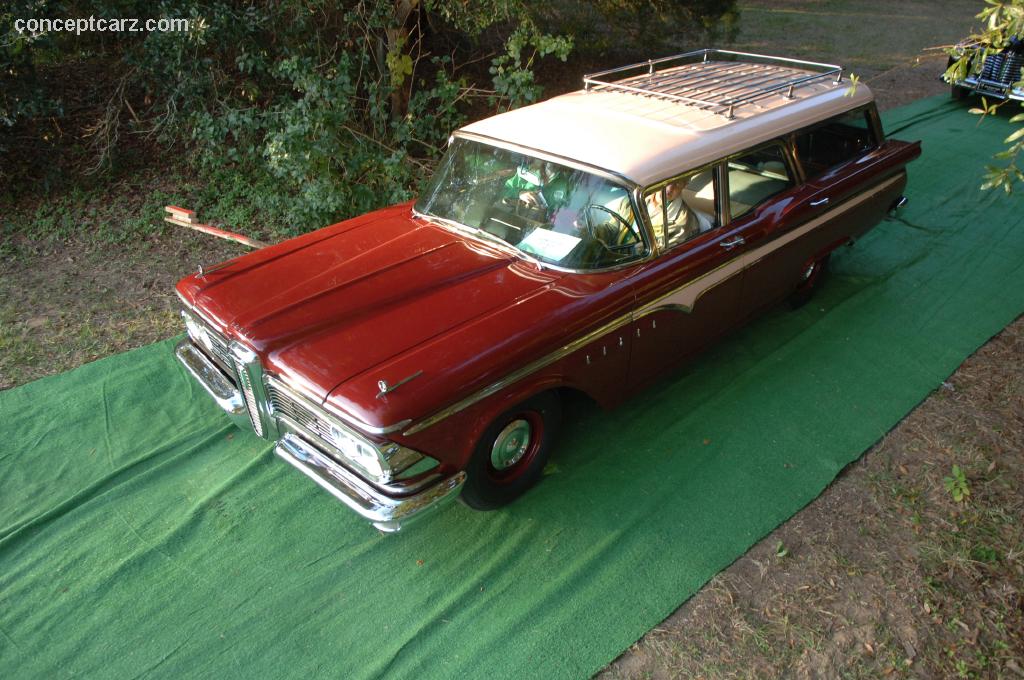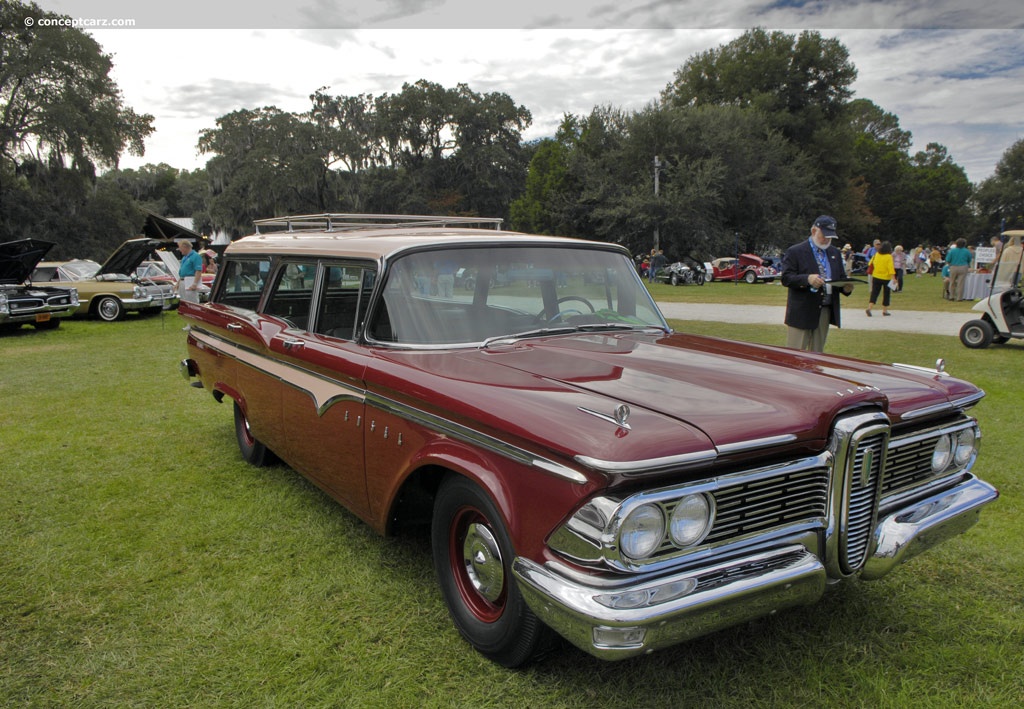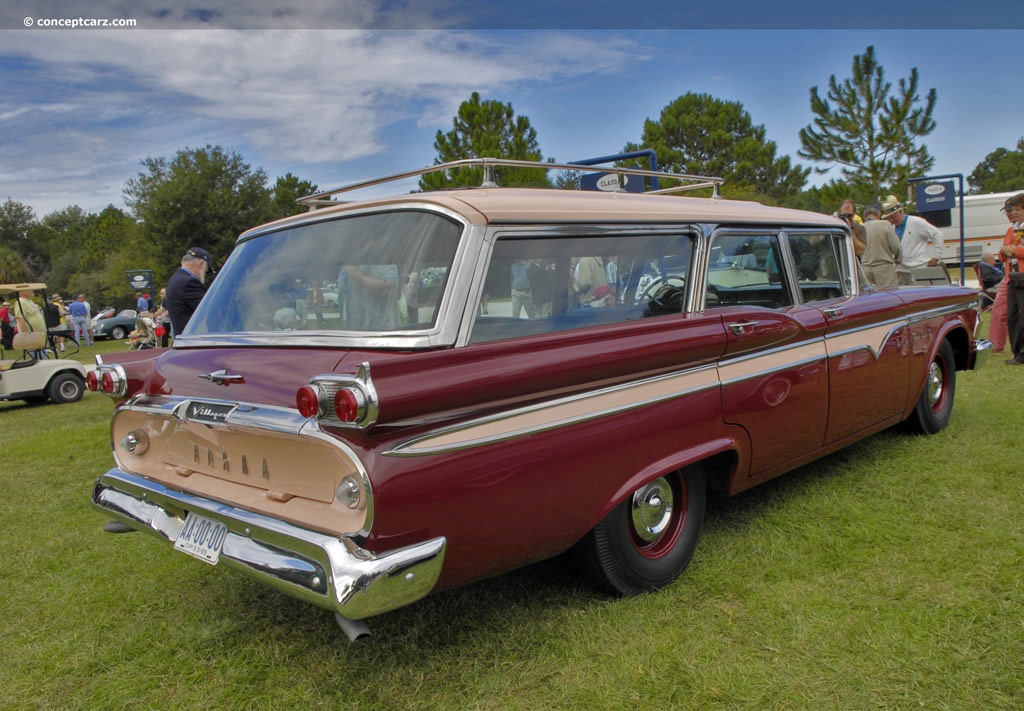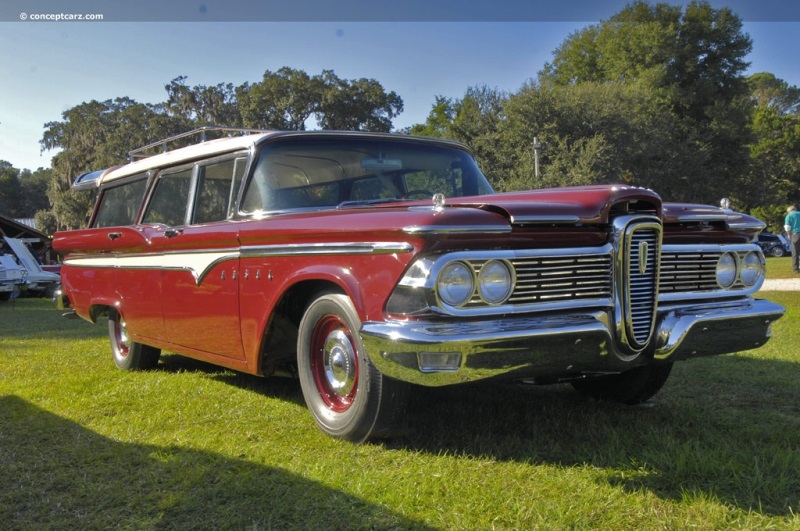The Edsel Automobile Company was in business from 1958 to 1960 and was part of the Ford Motor Company, joining the Lincoln-Mercury. Its bodies were shared with Mercury and Lincoln and were in a similar price range to the Mercury. 
Villager Station Wagon
View info and historyThe Korean Conflict shelved the initial plans for the Edsel company in the early 1950s. Plans resumed in 1954 along with the formation of the Special Products Division to develop the new car and brand. Designer Roy Brown was placed in charge of the project, code-named 'E-car' (with the 'E' referencing experimental) by Ford Motor Company chief stylist George Walker. The name Edsel was later selected in honor of Edsel B. Ford, the son of the company's founder, Henry Ford. The Edsel Division of Ford Motor Company was officially formed in November of 1956 and a dealer network soon followed, ultimately tallying 1,187 dealers giving the Ford Motor Company approximately 10,000 dealerships along its three divisions, bringing it on par with Chrysler (approximately 10,000 dealers as well) but trailing General Motors circa-16,000 dealers across six brands. The Edsel brand was introduced to the North American market via an extensive publicity campaign and released to the public on September 4th of 1957. Described as 'The Newest Thing on Wheels,' the Edsel brand offered 18 models in four basic series, including five station wagons. The list of models included the Citation, Corsair, Pacer, and Ranger with the Ranger and Pacer resting on a 118-inch wheelbase, the Corsair and Citation on a 125-inch platform, and the station wagons on a 116-inch wheelbase. Most models were equipped with the 'E-400' 361 cubic-inch, overhead valve V8 engine with slightly more than 300 horsepower, except for the Corsair and Citation which were powered by an 'E-475' 410 CID V8 with 345 horsepower. The Corsair and Citation used Edsel's exclusive Teletouch push-button transmission which was optional on the other models.The Edsel's short production lifespan is attributed to several factors including the recession years in which it was produced, stiff competition from a plethora of models throughout the industry, production problems and poor quality, steel shortages, unfavorable styling, and a lack of distinction from its Ford, Lincoln, and Mercury siblings. 
Villager Station Wagon
View info and historyThe 1958 Edsel Station Wagons included the two-door Roundup with seating for six at a base price of $2,840. Approximately 924 examples were produced, which was similar to the 892 of its more expensive four-door station wagon sibling, the Bermuda, priced at $3,155. In between them in regards to pricing was the Village, offered as a four-door station wagon with seating for either six- or nine-passengers with prices of $2900 and $2955 respectively. The 116-inch wheelbase of the Edsel wagons was shared with the Ford station wagons and used the same basic sheet metal, except for the rear fenders and taillights, and the front motif which was shared with the Ranger and Pacer series. Standard equipment on all wagons included ashtrays and cigarette lighter, dome and courtesy lights, two coat hooks, four armrests, and a white vinyl headliner. The Roundup was equipped with black rubber floor mats and a split front seat, the Villager had a solid bench front seat, and the Bermudas had color-keyed rubber floor mats and one-third/two-thirds design front seats. They also had chromed inside the rearview mirror and simulated woodgrain exterior paneling. The Ford Motor Company distinguished its mid-priced Edsel brand by incorporating numerous innovations, including a rotating dome speedometer, and a dashboard that used warning lights to indicate low oil level, overheating engine, and an engaged parking brake. A speed warning on the speedometer was displayed when the driver exceeded a preset speed limit. When equipped with the Teletouch push-button shifting system, the deep-dish steering wheel had the buttons mounted in the steering wheel hub. 
Villager Station Wagon
View info and historySafety features included childproof rear door locks, double-latched doors, self-adjusting brakes, and optional seatbelts. Edsel was one of the first automakers to introduce the remote-operated trunk opening. During its introductory year, Edsel produced 63,100 vehicles for the United States market and an additional 4,935 for Canada. Although far below predictions, the first year Edsel sales were bested only by the DeSoto introduction in 1929, marking the second-largest launch for any new car brand to date. 1959 Edsel
Only the most popular and highest-selling models were continued into the 1959 model year, including the Ranger and Corsair sedans and Villager station wagon. All Edsel vehicles now rested on a 120-inch wheelbase and shared their bodies with Ford, while the Mercury-based Edsels were dropped.
Villager Station Wagon
View info and historyThe highly criticized styling became more subdued for 1959, contrary to many of the designs throughout the industry which saw the highest tailfins ever applied to production vehicles, copious amounts of chrome trim, and the pinnacle of space-age styling. Edsel's vertical center grille design was heavily revised, and reworking the hood line moved the headlamps to the enlarged outer grilles. The trouble-pron Teletouch transmission shifter and the rotating-dome speedometer were removed and replaced by a slightly modified version of the dashboard used on the Ford Fairlane 500. Sales continued to decline, with 44,891 examples sold in the United States and 2,505 sold in Canada. 1959 Edsel Villager Station Wagon
The six-passenger Villager station wagon was priced at $2,970 and the nine-passenger listed at $3,055. Edsel built 5,687 examples of the six- and 2,133 of the nine-passenger wagon. Its wheelbase measured 118 inches, had an overall length of 210.1 inches, and rested on 8.00 x 14 four-ply tires. Standard equipment was similar to the previous year, including the cigarette lighter and two ashtrays, color-keyed rubber floor mats, a solid-back bench seat, and the 292 CID V8 shared with the Ranger. It had hydraulic valve lifters, five main bearings, 8.8:1 compression, and delivered 200 horsepower at 4,400 RPM. The optional 332 V8 delivered 225 horsepower. Transmission options included a three-speed manual with column control, a two-speed Mile-O-Matic transmission, and a three-speed Dual Drive automatic.
Villager Station Wagon
View info and historyThe styling was similar to the Ranger passenger vehicles with two circular lenses around the taillights, a full-width, oval-shaped beauty panel along the lower portion of the rear body, and the Villager nameplate in block letters. 1960 Edsel
Between October 15th and November 19th of 1959, Edsel built 2,846 vehicles for the 1960 model year, signaling the end of the failed experiment. The lineup included the Ranger sedans, hardtop, convertible, and the Villager station wagon. Styling changes were minimal, including a split grille with a single-piece front bumper, and four oblong taillamps in the back inset into the tailfins. Additional styling features that separated them from their Ford siblings included unique bumpers, body-side trim, and hoods. All Edsels produced in 1960 rested on one inch longer wheelbase than the Ford, measuring 120 inches.During Edsel's brief three-year production lifespan, they sold approximately 116,000 vehicles and lost an estimated $350 million.
by Daniel Vaughan | Feb 2021

Villager Station Wagon
View info and history

Villager Station Wagon
View info and history

Villager Station Wagon
View info and history
Only the most popular and highest-selling models were continued into the 1959 model year, including the Ranger and Corsair sedans and Villager station wagon. All Edsel vehicles now rested on a 120-inch wheelbase and shared their bodies with Ford, while the Mercury-based Edsels were dropped.

Villager Station Wagon
View info and history
The six-passenger Villager station wagon was priced at $2,970 and the nine-passenger listed at $3,055. Edsel built 5,687 examples of the six- and 2,133 of the nine-passenger wagon. Its wheelbase measured 118 inches, had an overall length of 210.1 inches, and rested on 8.00 x 14 four-ply tires. Standard equipment was similar to the previous year, including the cigarette lighter and two ashtrays, color-keyed rubber floor mats, a solid-back bench seat, and the 292 CID V8 shared with the Ranger. It had hydraulic valve lifters, five main bearings, 8.8:1 compression, and delivered 200 horsepower at 4,400 RPM. The optional 332 V8 delivered 225 horsepower. Transmission options included a three-speed manual with column control, a two-speed Mile-O-Matic transmission, and a three-speed Dual Drive automatic.

Villager Station Wagon
View info and history
Between October 15th and November 19th of 1959, Edsel built 2,846 vehicles for the 1960 model year, signaling the end of the failed experiment. The lineup included the Ranger sedans, hardtop, convertible, and the Villager station wagon. Styling changes were minimal, including a split grille with a single-piece front bumper, and four oblong taillamps in the back inset into the tailfins. Additional styling features that separated them from their Ford siblings included unique bumpers, body-side trim, and hoods. All Edsels produced in 1960 rested on one inch longer wheelbase than the Ford, measuring 120 inches.During Edsel's brief three-year production lifespan, they sold approximately 116,000 vehicles and lost an estimated $350 million.
by Daniel Vaughan | Feb 2021
Related Reading : Edsel Villager History
The Edsel Village was produced from 1958 through 1960, the entire lifespan of the Edsel marque. The Villager was a four-door station wagon built on a 116-inch wheelbase. It was the lower trim level of station wagons offered by Edsel. The Village came equipped with ashtrays, a cigar lighter, rubber floor mats, chromed rear-view mirror, crank-operated rear windows, a two-piece tailgate, and armrests.....
Continue Reading >>
Continue Reading >>
Similar Vehicles
Similarly Sized Vehicles
from 1959
Similarly Priced Vehicles
Austin-Healey 3000 MK I ($3,050-$3,370)
Ford Galaxie ($590-$3,350)
Plymouth Suburban ($2,570-$3,135)
Oldsmobile Dynamic 88 ($2,835-$3,360)
Mercury Country Cruiser ($3,030-$3,930)
Chevrolet Bel Air Series ($2,400-$3,000)
DeSoto Firesweep ($2,900-$3,500)
Plymouth Fury ($2,700-$3,130)
Average Auction Sale: $19,493
Ford Galaxie ($590-$3,350)
Plymouth Suburban ($2,570-$3,135)
Oldsmobile Dynamic 88 ($2,835-$3,360)
Mercury Country Cruiser ($3,030-$3,930)
Chevrolet Bel Air Series ($2,400-$3,000)
DeSoto Firesweep ($2,900-$3,500)
Plymouth Fury ($2,700-$3,130)
Average Auction Sale: $19,493
1959 Edsel Station Wagon Vehicle Profiles
Recent Vehicle Additions
Performance and Specification Comparison
Price Comparison
$2,630 - $2,760
$2,810 - $3,075
Villager Specification Comparison by Year
Year
Production
Wheelbase
Engine
Prices
Related Automotive News

1938 BUGATTI TYPE 57C WINS ‘BEST OF SHOW' AT 2014 HILTON HEAD ISLAND MOTORING FESTIVAL & CONCOURS D'ELEGANCE
Hilton Head Island Concours dElegance attendees select 1929 Chrysler Model 75 Dual Cowl Phaeton for Peoples Choice Award
HILTON HEAD ISLAND, S.C. – The coveted Best of Show and Peoples Choice honors were awarded today at the 13th...
HILTON HEAD ISLAND MOTORING FESTIVAL TO FEATURE CARS OF THE RICH & FAMOUS
This years Life exhibit puts the spotlight on cars with headline heritage
HILTON HEAD ISLAND, S.C. – The Hilton Head Island Motoring Festival %26 Concours dElegance, one of the nations largest and fastest-growing automotive and motorsports...

Carl Edwards Drives Historic 1901 Sweepstakes Race Car In Advance Of Henry Ford'S 150Th Birthday Celebration
Ford Racing NASCAR superstar Carl Edwards was given the honor of driving the legendary Sweepstakes race car built and raced to victory by Henry Ford in his one and only race in 1901.
Edwards drove the car around the grounds of Greenfield Village...

Commemorative Poster For 2013 Pebble Beach Concours d'Elegance Features Ford Family Lincolns
Event Posters Also Celebrate Aston Martin and Porsche 911
PEBBLE BEACH, Calif. (April 16, 2013) -- When Edsel B. Ford II came upon the 1956 Lincoln Continental MK II last year, he admired the long lines and elegant custom styling of the...

Limited-Edition Ford Racing History Artwork Unveiled at SEMA; Limited-Edition Print Sales to Benefit JDRF
Special limited-edition Ford Racing history artwork is unveiled at the annual SEMA show as part of the Ford press conference
Famed automotive artist Sam Bass created the artwork at the request of Edsel B. Ford II, with proceeds from sales of limit...























